The Pyramids of Ancient Egypt
The Egyptian pyramids remain one of the most beautiful and complex mysteries of the modern world. Set against the exotic backdrop of the Egyptian desert, these stone temples hearken our memories back to the days of pharaohs and mummies. Throughout history there have been many theories regarding the exact manner in which the Egyptian pyramids were built.
Location of Egyptian Pyramids
The Egyptians built all their pyramids on the West bank of the Nile. Scholars have found around 100 pyramids in Egypt and more are likely buried under the sand. The most important pyramid complexes are at Saqqara, Meidum, Dahshur and Giza. Some pyramids are only mud-brick remnants now.
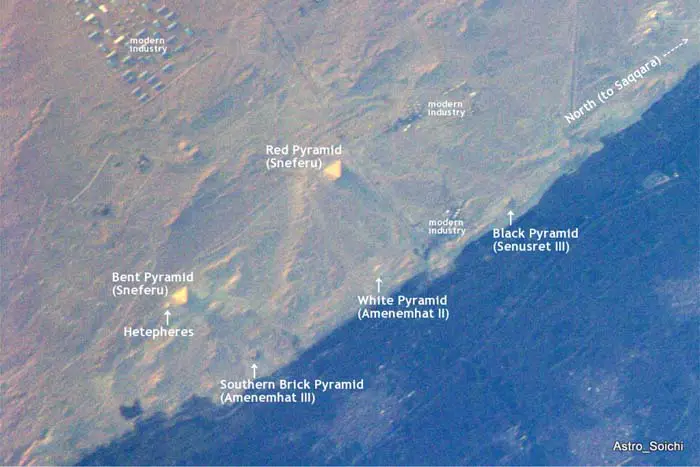
© the mad LOLscientist - The Pyramids at Meidun
History of Egyptian Pyramids
The first pyramid built in Egypt was the Step Pyramid of Djoser, during his reign in the Third Dynasty. This pyramid was built by Imhotep, one of the earliest known architects and engineers. The step pyramid was the first monumental stone building constructed in Egypt. The remaining kings of the Third Dynasty started step pyramids, but their reigns were short and none completed their projects.
Snefru's reign marks the change from step to cased or true pyramids. His four completed projects set the stage for his successors, who built the famous complex at Giza.
Pharaohs of the Middle Kingdom also built pyramids, although little of these structures remains. The workers built these pyramids of mud brick around a rubble core. Today, all that remains are mounds and sand has covered some of them. Egyptologists are still finding some of these pyramids.
Egyptian Pyramid Symbolism
Most scholars believe that most pyramids represent the benben. The benben was the mound that rose from the primordial waters in the Heliopolis creation myth. The creator god stood on the mound to create mankind, the gods and the world.
A small benben was in Ra's temple at Heliopolis. The Egyptians believed this was the first place the sun's rays touched each dawn and might have seen the capstones of the pyramids as a form of the benben. Obelisks were also a representations of the same concept, as well as small pyramid-shaped stones some Egyptians built.
Step pyramids have specific beliefs associated with them. Scholars believe the Egyptians saw them as a stairway to the stars. The pharaoh's soul would climb them to take his place in the stars to be joined with Ra.
Scholars believe true pyramids might reflect a change in religious ideas. Snefru moved his capital and began building true pyramids in the middle of his reign. Scholars think he was trying to associate himself with Ra before his death, as the power of Ra's priests was rivaling his own. The Egyptians might have thought the true pyramids represented the sun's rays as they touched the earth.

The sunrise in the myth of creation
How Egyptian Pyramids were Built
In recent decades, scholars have devoted excavations to learning about the builders and the methods the Egyptians used to construct pyramids. While the information comes mostly from the Giza complex, other pyramids were probably built in the same way.
The pharaoh and his vizier chose a good site for the pyramid.
The engineers oriented the plans to the cardinal points and laid out the base's outline. After they leveled out the site, except for a small mound in the center, they laid a layer of limestone or granite over the bedrock.
The builders leveled the stone layer, and they were very accurate. At Giza, workers built a quarry for limestone, with a ramp leading to the base of the pyramid. They dragged stone blocks on sledges over the ramp.
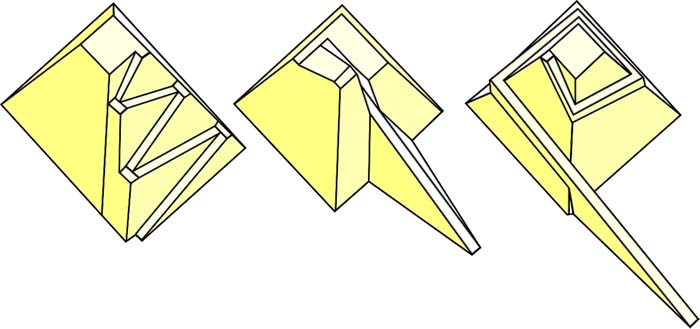
© Althiphika - Different types of ramps
As the pyramid rose, workers built the ramp higher and wrapped it around the pyramid. After completing the construction, carvers smoothed the casing blocks to create a smooth surface. The workers then disassembled the ramp as they smoothed the outer blocks, working from the top down.
Most pyramids were part of a large complex, often meant for a funerary cult to honor the pharaoh after his death. The opening to the complex was at the pharaoh's valley temple, where offerings for the pharaoh's cult came in. There were also courtyards, buildings to store goods, housing for priests, boat pits and a cult pyramid.
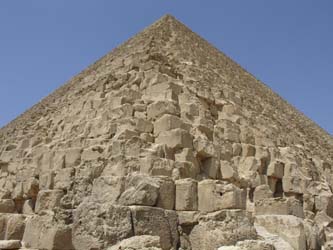
© Mgiganteus1 - Giza Pyramid Blocks
The workers who built the pyramids were Egyptians, not slaves, as previously thought. Farmers lived in worker villages and built the pyramids while the Nile was flooding. They had dining rooms, breweries and bakeries. Bones found in the workers' village suggest that they ate meat every day.
Scholars have excavated a cemetery for pyramid workers at Giza. The tombs helped them understand how the administrative organization of the builders worked. Administrators divided workers into crews that had names and overseers regulated every aspect of the building.

© Depiction of workers moving a colossus
As time went on, pharaohs stopped building pyramids, yet the exact reason for this change is unknown. Many scholars think pharaohs started building rock-cut tombs to stop grave robbers. Similarly to the previous periods, the change could represent shifts in religious ideas, but it is still uncertain.
Interiors
The burial chambers of most pyramids were underneath the structure. Some of Snefru's pyramids and the Great Pyramid were exceptions to this rule. In these cases, the burial chambers were inside the structure, along with many false corridors and chambers. This was likely an attempt to confuse grave robbers. No pyramids had traps, the builders depended on the confusing passageways to protect the burial.
Engineers designed the internal chambers to support the weight of the pyramid. The Great Pyramid had a unique feature, shafts leading from the king's chamber. At first, scholars thought they were ventilation shafts, but some do not reach the outside.
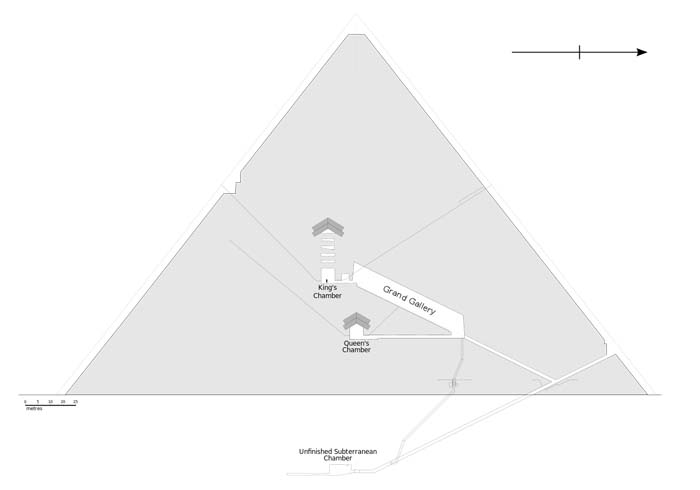
© Jeff Dahl - Diagram of the Great Pyramid's chambers
Pyramids of Giza
The Great Pyramid
Khufu built the Great Pyramid around 2506 BC. It is 481 feet high and 756 feet long at the base. The engineers oriented the pyramid to the cardinal points, and they were accurate to within a fraction of a degree. There are three burial chambers in or under the Great Pyramid.
The first chamber built was under the Great Pyramid and it was not finished, followed on a vertical axis by the Queen's and the King's Chambers. Five small relieving chambers over the King's Chamber support the pyramid's weight.
Egyptologists have found the remains of Khufu's funerary complex. Scholars excavated five boat pits, two with boats that they have reconstructed. At first, they did not think Khufu's complex had a cult pyramid, but the remains were found recently.
Discover more about the Great Pyramid of Giza...
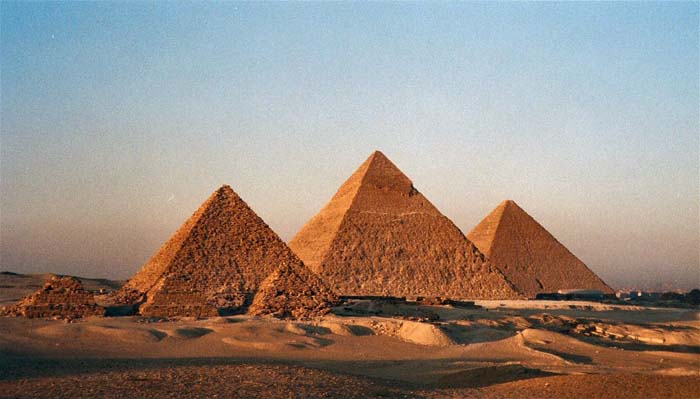
© Bruno Girin - The pyramids of Khufu, Khafre and Menkaure
Khafre's Pyramid
The pyramid built by Khufu's son, Khafre, is a little smaller than the Great Pyramid. They appear to be the same size because Khafre's pyramid is at a higher elevation. Scholars have excavated most of his funerary complex, which has a unique feature, the Great Sphinx.
The Egyptians carved the Great Sphinx from a sandstone outcropping, likely as a guardian to protect the Giza complexes.
Menkaure's Pyramid
Menkaure's Pyramid is only one-tenth the size of the Great Pyramid. Instead of building a huge pyramid, Menkaure built one of more valuable stone. The base layer and the bottom sixteen layer casings were granite. Workers finished the pyramid with limestone after the pharaoh's death.
Other Famous Pyramids
Djoser's Step Pyramid
The Step Pyramid of Djoser at Saqqara was the first pyramid. It was originally a large mastaba, a square flat-topped mound. Five more mastabas, each smaller than the previous one, were built on top of the bottom layer. The result was the first step pyramid, and it was 204 feet high.

© John Solaro - Djoser's Step Pyramid
The Bent Pyramid
Snefru's first pyramid at Dahshur, the Bent Pyramid is the first true pyramid. At first, its walls had a 60 degree angle. When the pyramid reached the height of 131 feet, cracks developed in the interior corridors and the outer casing, possibly due to the steep angle of the walls.
Engineers placed a girdle around the lower levels and built the upper part of the pyramid at a 43 degree angle. Scholars found two burial chambers, although there could still be undiscovered chambers or passageways inside this pyramid.

© Phil - Snefru's Bent Pyramid
The Red Pyramid
Snefru also built the Red Pyramid at Dahshur, with a red limestone core. The interior structure, however, was much less complex than that of the Bent Pyramid.
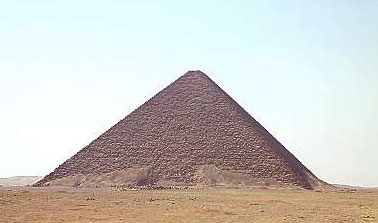
© Don McCrady - Snefru's Red Pyramid
Egyptian Pyramids Facts and FAQ
- The Egyptians saw pyramids as representations of the benben.
- Pyramids symbolized staircases to the stars, or the rays of the sun touching the Earth, the concepts changing according to shifts in religious beliefs.
- Djoser built the first pyramid, a step pyramid, at Saqqara.
- Snefru built the first true pyramid at Dahshur.
- Snefru's son, Khufu, built the Great Pyramid at Giza.
- The theories about the builders of the ancient Egyptian pyramids are largely debated. It appears that, contrary to popular belief, the pyramids were built by Egyptian workers, and not slaves.
- Scholars learned about the administration of the pyramid builders from their cemetery and village.
- The pyramids were built on the West Bank of the Nile, with the most important complexes at Saqqara, Meidum, Dahshur and Giza.
- Most pyramids were part of a funerary complex.
- Temples, courtyards, boat pits, small pyramids and a cult pyramid were part of the complex.
What did the pyramids represent?
Who built the pyramids?
Where were the pyramids built?
Why did the Egyptians build the pyramids?
